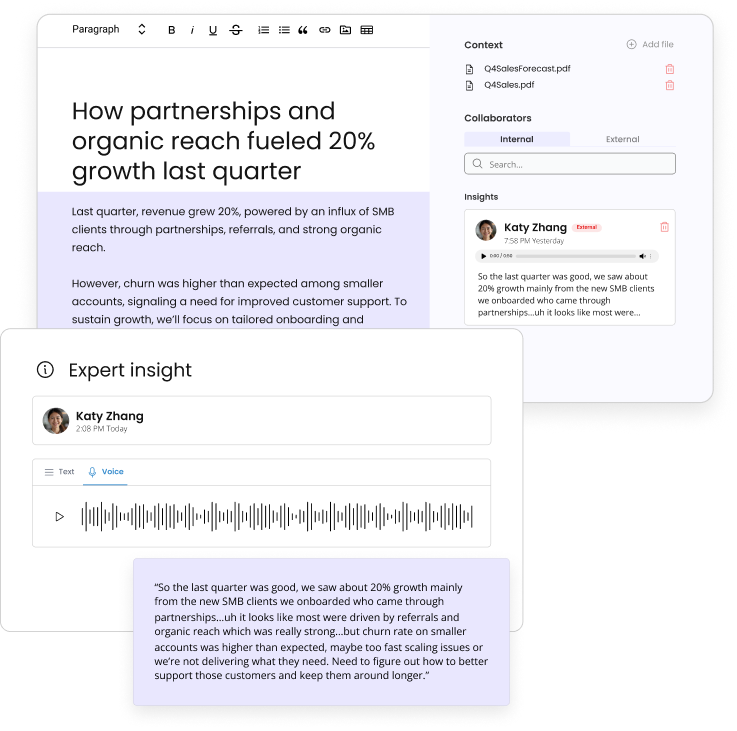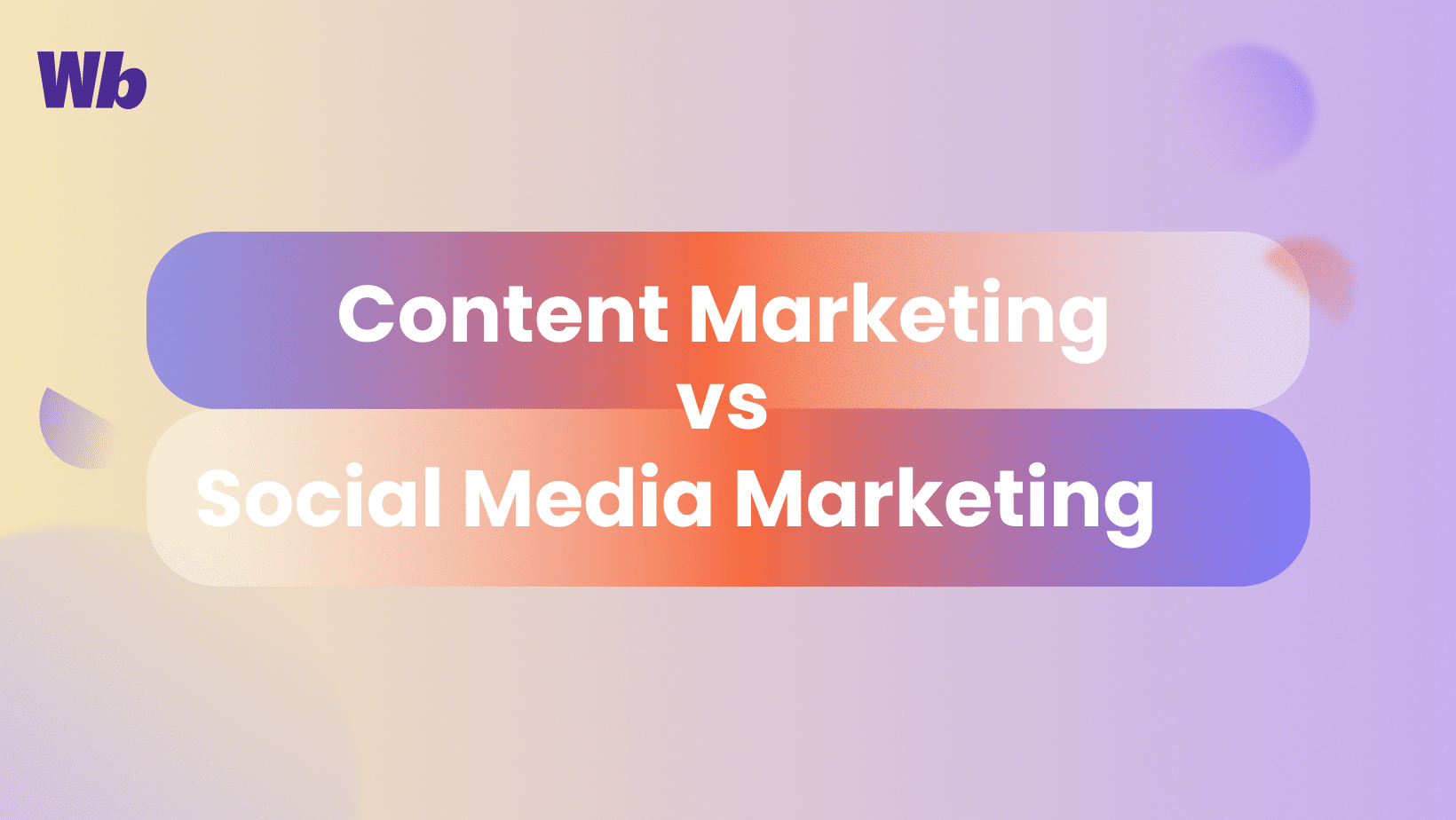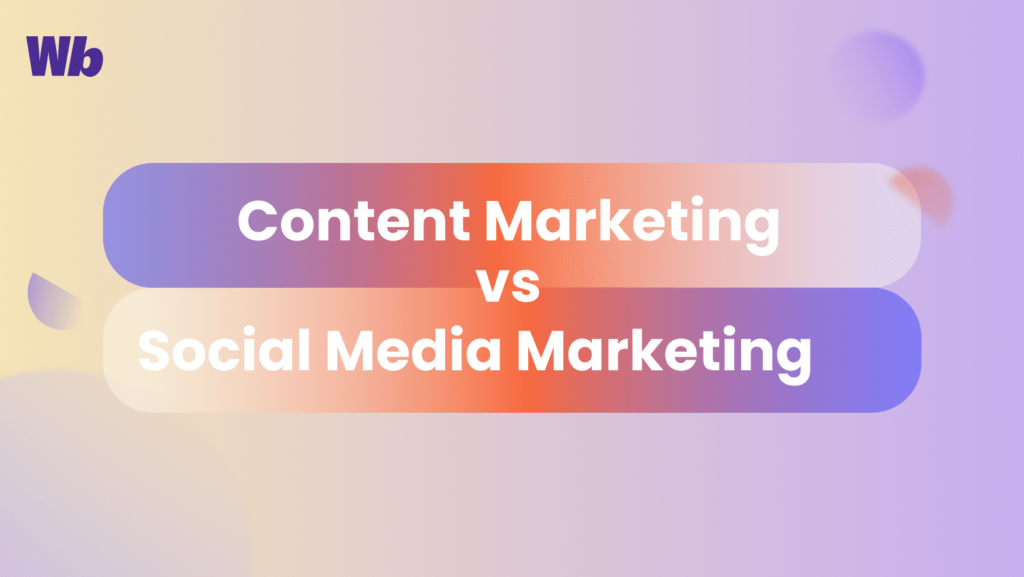Table of Contents

Authority scales when expertise comes first
Wordbrew helps teams collect expert insight before AI ever writes a word.
Built for expert-led, review-safe content
- Home
- »
- Content Marketing
- »
- Social media marketing vs content marketing: A content expert’s deep dive
-
Wordbrew
- 10 minutes read time
Social media marketing vs content marketing: A content expert’s deep dive
- Home
- »
- Content Marketing
- »
- Social media marketing vs content marketing: A content expert’s deep dive
Social media marketing vs content marketing: A content expert’s deep dive
Table of Contents

If you think social media marketing and content marketing are the same thing, think again. The two work in tandem, sure. Your content marketing strategy can and should spill over into your social media marketing. But, you’ll need separate strategies to leverage the unique benefits of both—to build brand awareness, increase customer retention, and drive conversions.
Still confused? This deep dive into differences—and overlaps—between the two will help you out.
TL;DR
- Use shorter, punchier social content via platforms such as Instagram, to increase brand awareness, distribute your content, and build a community among your audience.
- Longer form content and videos hosted on your own website as part of your content marketing strategy drive trust and increase visibility in the long term, encouraging higher conversion rates.
- Use both as part of an integrated marketing strategy to maximize ROI.
Understanding the basics
Social Media Marketing:
At its core, social media marketing is the use of platforms like Facebook, Twitter, Instagram, Tik Tok and Youtube, to promote products, services, or content. It emphasizes creating and fostering direct and indirect engagement with potential customers and followers, turning passive viewers into active participants in brand conversations.
Pros
Immediate Engagement: Posts can go viral within hours, leading to instant brand recognition and sales. The potential reach is astronomical. Instagram alone boasts over 1.2bn monthly active users—28% of global internet users.
Audience Interaction: It allows direct interaction with your audience, humanizing your brand and showcasing your unique personality and values, which fosters loyalty and develops stronger customer relationships.
Targeted Advertising: Platforms like Facebook or Instagram allow businesses to target specific demographics, maximizing the efficiency of ad spend.
Cons:
Short-lived Content: Social media posts have a short lifespan—ranging from a mere 15 minutes on Twitter to 20 days or more on YouTube—meaning businesses must post regularly to be heard.
Platform Dependency: Any changes in the platform’s algorithm or policy can significantly affect how far your posts reach, and potentially upend your marketing efforts.
Time Consuming: You can’t just post on social media and leave. Think of each post as the start of a two-way conversation you must be present for and committed to following.
Content Marketing
Content marketing is a strategic approach to crafting valuable and relevant content to captivate and retain a well-defined audience. Whether through blog posts, videos, or infographics, content marketing aims to elevate brand trust, fortify its credibility, and drive profitable customer actions.
It works. Research has shown content marketing is three times more effective for demand generation than traditional outbound marketing strategies, and costs 62% less.
Pros
Longevity: Content, especially evergreen content, can continually drive traffic to your website. One well-researched article ranking well in the SERPs can provide value for years.
SEO Advantage: High-quality content boosts search engine visibility, driving organic traffic to your site. Google’s search algorithms value one thing above all else when ranking web pages: EAT. Expertise, Authority, and Trustworthiness. Content marketing gives brands a platform from which to demonstrate all three.
Authority and Trust: Over time, delivering consistent and valuable content positions your business as an industry leader. In a survey by the Content Marketing Institute in 2022, 88% of marketing decision-makers who have used content marketing to build credibility and trust have found the strategy to be effective in achieving those goals.
Cons:
Time Intensive: Creating quality content can be time-consuming, and the results might not be immediate. Even with excellent optimization, it can still take a webpage three to six months to rank on the first page of the Google SERPs. The wait could be even longer if competition for the search term you’re targeting is high.
Requires Expertise: Whether it’s writing a blog post, creating a video, or designing an infographic, the content must be high-quality, which might necessitate hiring specialists.
Social media marketing and content marketing: two sides of the same coin.
While content marketing provides valuable information or entertainment to the audience, social media gives them a platform to interact with this content and the brand. A blog post can be shared on Twitter, generating discussions, while an infographic on Instagram can lead followers to a detailed article on the brand’s website.
Social media marketing: Beyond just posts
Don’t think about social media as one homogeneous site. Each platform attracts a unique demographic and requires a separate strategy. A fashion brand might find more traction on Instagram with its visual-heavy content, while a B2B company could benefit more from LinkedIn’s professional audience.
Let’s take British fashion brand ASOS as an example. It uses video-led posts on Instagram to encourage interaction with its customers, showcasing its latest styles in a more engaging format than static images.
The likes and shares on the post provide quantitative insights to gauge the audience reception of the products, while comments offer data on customer sentiment, concern, and needs.

By analysing the reaction to their posts on Instagram, companies like ASOS can stay ahead of the curve, understand trends, and feed customer behavioral change into their content marketing strategy to keep it useful and relevant.
Content marketing: Not just words, but strategy
Over 4.4million blog posts are published daily across all platforms. So, how do you get your content to stand out? Only original and valuable content breaks through the noise. It’s about offering insights or entertainment that’s not available elsewhere. Simply writing blog posts in great quantity isn’t going to cut it. You need a strategy to create quality content, regularly.
A well-executed content strategy showcases your brand’s authority in your field. Over time, customers trust and rely on your content, viewing your brand as a thought leader.
Good content can then boost other marketing strategies, from SEO to email marketing. It’s the fuel that drives all digital marketing engines.
With its ‘The 7’ email newsletter, The Washington Post does a great job repurposing its online content into an email marketing campaign. It’s a simple tactic—rounding up and providing a short overview of a few of its top-performing stories to encourage readers to click through and find out more.

(Source: Hubspot)
What’s the difference between social media marketing and content marketing?
In a nutshell, social media marketing is all about creating and sharing content via social platforms such as Instagram, Facebook, or TikTok, while content marketing refers to the content you create for your own website. But will both be Clear as mud? Let’s take a deeper look at the differences between the two.
- Control and creation: Social media is dynamic, with both brand and audience shaping the conversation. User-generated content, for example, is easily shared via social media and can boost campaigns with little input from the brand itself. Content marketing, on the other hand, is predominantly controlled by the brand.
The #MyParachuteHome campaign from interiors brand Parachute is a clever way to
get its target audience doing its marketing. By encouraging user-generated content,
Parachute is able to increase its reach and show its products in real-life scenarios,
without needing to increase ad spend, or spam its own social feeds with multiple,
Similar posts. It can piggyback off the ‘how it started, how it’s going’ trend to
stay current.

By contrast, its content marketing is driven by its in-house expertise and each blog post is carefully crafted to position it as a leader in home interiors.

(Source: Parachute Home)
- Channels: While social media marketing resides on third-party platforms, most content produced as part of a content marketing strategy will primarily live on the brand’s own domain, ensuring long-term visibility and SEO benefits. The content might take the form of blog articles, videos, how-to guides, white papers, or
- Content length: Social media marketing thrives on brevity, with snappy tweets or eye-catching images. Content marketing can delve deeper, offering comprehensive insights through long-form content.
The recommended character limit for a Facebook post—the amount research has shown is likely to get you the most engagement and interactions—is just 50 characters. Instagram posts show a similar trend.
A blog post taking a deep dive into a specialist subject—like this one—needs to come in around 2,000 words to stand a chance of being deemed useful and authoritative enough to rank highly in the Google SERPs.
Any less than 500 words, and you’re likely to be wasting your time.
Remember, you can—and should—repurpose your content marketing into your social media marketing. Pick out statistics, quotes, infographics, or short sections of text to turn into images that engage your audience and compel them to read more.
Here’s how we do it at Wordbrew:
Read more brewed insights in the world of content marketing:

Social media posts are much shorter, and are used for content distribution, interaction, and sharing.

(Source: Instagramhttps://www.instagram.com/wizeo.io/)
- Objectives: Social media marketing aims to engage and foster community, while content marketing seeks to inform, educate, and convert.
Moz’s blog pages are a great example of a brand using their content marketing to position themselves as the leading experts in their industry. In this case, search optimization. They use their blogs to build trust and authority to encourage their target audience to sign up for their services.

(Source: Moz)
By contrast, Patagonia’s social media pages are a great example of a brand using the visual-heavy Instagram to build a community and sell a lifestyle—rather than directly selling their clothes. For Patagonia, social is not about sales conversions; it’s about brand perception. They engage with their community and foster a sense of belonging, boosting customer retention.

(Source: Instagram)
- Measurement: Measuring social media marketing performance involves tracking key metrics such as likes, shares, comments, click-through rates, and conversion rates. When you analyze the data, you can identify trends, understand your audience’s behavior, and adjust your strategy accordingly. This data can then help inform your wider content marketing strategy.
To measure the success of your content marketing, you’ll want to track metrics such as website traffic, engagement, and conversion rates via platforms like Google Analytics. You can also monitor the performance of individual pieces of content, assessing factors like click-through rates, social shares, and the time readers spend on the page.
Social Media Marketing Content Marketing Control and Creation Limited control over content due to platform rules; Emphasis on real-time engagement and quick content creation. Full control over content creation; Focus on long-form, evergreen content tailored to specific goals. Channels Primarily utilizes social media platforms (e.g., Facebook, Twitter, Instagram, LinkedIn) for distribution. Utilizes various channels, including websites, blogs, email marketing, and social media, for content dissemination. Content Length Typically shorter, with a focus on concise posts, tweets, and stories to capture immediate attention. Often longer, featuring blog articles, ebooks, videos, and infographics designed for in-depth information and audience education. Objectives Goals include increasing brand visibility, driving website traffic, building a social media following, and fostering engagement. Goals revolve around building brand authority, lead nurturing, establishing customer relationships, and providing value to the audience. Measurement Metrics measured may include likes, shares, comments, click-through rates, and follower growth. Metrics measured include traffic, conversion rates, time on page, email open rates, lead generation, and brand mentions.
(Table explaining the key differences between social media marketing and content marketing)
Integrate content marketing and social media marketing for the best results
Sharing content on social platforms extends its reach, helps you tap into new audiences, and sparks discussions with your customers. But, without quality content, social media engagement lacks depth. Conversely, without social media, even great content can remain unseen.
The true power of social media and content marketing comes when the two are intertwined, creating a cohesive, multi-channel strategy that takes advantage of both.
What’s the future of social media marketing and content marketing?
Looking ahead, it’s likely the boundaries between social media marketing and content marketing will continue to blur as online platforms—and the algorithms that drive them—evolve.
What proves effective today for either strategy might become obsolete tomorrow. This dynamic nature underscores the importance of continuous learning and adaptability for marketers. Staying abreast of the latest trends, algorithms, and consumer behaviors is crucial to staying competitive and ensuring marketing efforts remain relevant and effective.
However, there are potential pitfalls to navigate. Failing to develop an integrated marketing strategy combining content and social cohesively can result in disjointed efforts. This fragmentation can lead to reduced efficiency, wasted resources, and, ultimately, a diminished return on investment (ROI).
There’s no point in having high-value, informative blogs on your website if no one reads them. Equally, there’s little point in using social media to build a community around your brand if you never leverage the opportunity to convert them into customers. You need a well-thought-out, holistic approach that combines the strengths of social media marketing and content marketing to achieve your objectives effectively.
ROI analysis of social media marketing and content marketing
When it comes to ROI, in the long term, content marketing has the edge over social media.
Let’s say you spend $1,000 on creating a well-researched article. If that article drives an average of 100 visitors per month to your site for 3 years, that’s 3,600 visitors. If your conversion rate is 2%, that’s 72 customers. If each customer spends an average of $50, that’s $3,600, resulting in an ROI of 260%.
Let’s take that $1,000 and spend it on a social media ad campaign instead. You reach 10,000 people, with 1,000 clicking through to your site. If your conversion rate is 2%, you get 20 customers. Again, if each customer spends $50, that’s $1,000 in revenue, leading to an ROI of 0%.
Of course, these are simplified examples, and actual numbers can vary. But it’s not all bad news for social.
Which is better? It depends.
We hate to end on a less-than-definitive note, but whether you are better at choosing a social media marketing strategy or a content marketing strategy does depend on your brand. Which is going to work best for you depends on your budget, your audience, and your industry—knowing your brand and its customers is an imperative first step.
Budget & resources: If you’re on a tight budget and can’t afford frequent content creation, leaning into social media might offer quicker wins. On the contrary, if you can invest in quality content, the long-term ROI is promising.
Target audience: Where does your audience hang out? If they’re avid readers or researchers, a blog might serve you better. If they’re younger and spend hours on Instagram or TikTok, social media marketing might be more effective.
The nature of your business: A B2B business might find value in in-depth whitepapers, while a fashion brand will likely thrive on visual platforms like Instagram.
It’s all about the integration
While social media marketing and content marketing have distinct characteristics, they’re most potent when used together. As the lines continue to blur, understanding and leveraging each strategy’s unique strengths will be paramount for modern marketers. Embracing an integrated approach is not just a recommendation; it’s a necessity for brands looking to flourish in today’s interconnected digital ecosystem.
Like what you’re reading? Here’s more great content for the content marketer in you:
